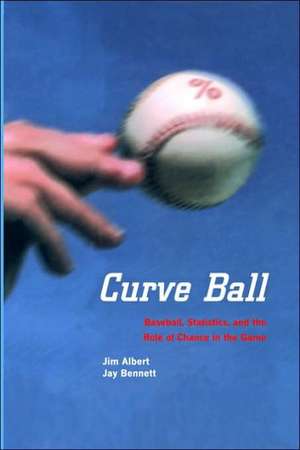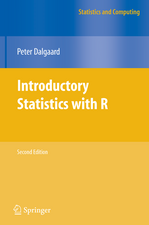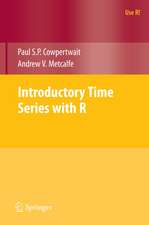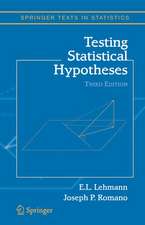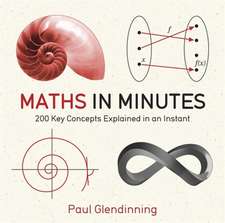Curve Ball: Baseball, Statistics, and the Role of Chance in the Game
Autor Jim Albert, Jay Bennetten Limba Engleză Hardback – 8 iun 2001
| Toate formatele și edițiile | Preț | Express |
|---|---|---|
| Paperback (1) | 321.07 lei 3-5 săpt. | |
| Springer – 8 apr 2003 | 321.07 lei 3-5 săpt. | |
| Hardback (1) | 315.83 lei 3-5 săpt. | |
| Springer – 8 iun 2001 | 315.83 lei 3-5 săpt. |
Preț: 315.83 lei
Nou
Puncte Express: 474
Preț estimativ în valută:
60.44€ • 64.62$ • 50.39£
60.44€ • 64.62$ • 50.39£
Carte disponibilă
Livrare economică 27 martie-10 aprilie
Preluare comenzi: 021 569.72.76
Specificații
ISBN-13: 9780387988160
ISBN-10: 0387988165
Pagini: 350
Ilustrații: XVIII, 410 p.
Dimensiuni: 155 x 235 x 28 mm
Greutate: 0.67 kg
Ediția:2001
Editura: Springer
Colecția Copernicus
Locul publicării:New York, NY, United States
ISBN-10: 0387988165
Pagini: 350
Ilustrații: XVIII, 410 p.
Dimensiuni: 155 x 235 x 28 mm
Greutate: 0.67 kg
Ediția:2001
Editura: Springer
Colecția Copernicus
Locul publicării:New York, NY, United States
Public țintă
Popular/generalDescriere
In its formative years, from the 1970s through the 1990s, sabermetrics was p- marily an amateur undertaking. Publications were aimed at a relatively small audience of baseball fans. To be sure, this ever-growing group of aficionados brought a lot of sophistication to baseball analysis, and were constantly looking for statistical insights beyond the listings of the top ten batters found in popular newspapers and magazines. But their influence on the baseball profession was very limited. A few consultants like Craig Wright developed temporary relati- ships with various teams, but none were able to stay long enough to create a p- manent sabermetrician staff position. (See Rob Neyer’s November 11, 2002, arti- 1 cle on ESPN. com. ) All of this changed, however, in 2002 with the hiring of Bill James by the Boston Red Sox. With that move, we have seen the admittance of the foremost proponent of sabermetrics into the top echelon of professional ba- ball management. The art and science of careful statistical analysis, it now seems, had made it into the big leagues. Since the publication of the first edition of Curve Ball in 2001, we have been overwhelmed by the positive responses from readers and critics. We’re pleased with the reception, of course, but we don’t want to rest on our laurels. Like a pitcher refining his repertoire, we’ve revised, expanded, and updated the book for its publication in this paperback edition. Several readers and critics took us 1 http://espn. go. com/mlb/columns/neyer_rob/1456664.
Cuprins
Preface to the Paperback Edition; Introduction; Ch01: Simple Models from Tabletop Baseball Games; Ch02: Exploring Baseball Data; Ch03: Introducing Probability; Ch04: Situational Effects; Ch05: Streakiness (Or, The Hot Hand); Ch06: Measuring Offensive Performance; Ch07: Average Runs per Play; Ch08: The Curvature of Baseball; Ch09: Making Sense of Baseball Strategy; Ch10: Measuring Clutch Play; Ch11: Prediction; Ch12: Did the Best Team Win?; Ch13: Post-Game Comments (A Brief Afterword); Appendix: Baseball Games; Glossary; Bibliography; Index
Recenzii
From the reviews:
"...a most interesting and useful introduction to the subject. It should make enjoyable reading for physicists who are also baseball fans, and it ought to be required reading for baseball managers, executives, and commentators." PHYSICS TODAY
"...a smart and energetic collection of essays on baseball statistics. Curve Ball doesn't play misty-eyed homage to baseball's traditions and conventional wisdoms....This is great stuff....Curve Ball makes clear how pleasurable [stats] can be, and arguably how important, to view the great American game with real precision." -- The Wall Street Journal
"Rating: 4.5 out of 5. Must own!" -- Baseballnotebook.com
"In [Curve Ball] Albert & Bennett explain the game in ways the conventional press - even titans such as Bill James - cannot." -- Baseball America
"[The book] illustrates how statistical reasoning can be useful in teasing out the role of chance from performance in baseball to better assess ability....Curve Ball represents another advance in the genre of baseball and statistics books." -- Journal of the American Statistical Association
"This is a very good, fun and highly interesting book, applying some straightforward, and some more difficult, statistical estimation and modeling concepts to baseball. … I am a statistician, and mostly Bayesian at that, and this definitely enhanced my interest and enjoyment of the book. … Initially this book starts out as a sneaky introduction to statistics and Bayesian concepts, however, it turns into a delight for sports fans and statisticians alike. Highly recommended … ." (Richard Gerlach, Gazette, Vol. 31 (5), 2004)
"This book treats a wide variety of topics, including: comparing measures of batting ability; the impact of situation on performance; streaks; measuring a player’s clutch performance; and did the best team win the World Series. This book has the appealing quality that you can start reading at almost any chapter and enjoy and understand the journey. And for those of us who are not statisticians by training, we can also learn some statistics." (Zentralblatt für Didaktik der Mathematik, September, 2003)
"Curve Ball … is a necessary addition to any library. … Written for all followers of baseball, this book caters to those who find joy in reading (and if you are like me, memorizing) the statistics on the backs of baseball cards or who played baseball simulation games … . For readers possessing no knowledge of statistics, this book is a great way of learning how to view and interpret data from a statistician’s standpoint. Readers with statistics backgrounds will enjoy the book … ." (Jonathan L. Templin, Chance, Vol. 15 (4), 2002)
"...a most interesting and useful introduction to the subject. It should make enjoyable reading for physicists who are also baseball fans, and it ought to be required reading for baseball managers, executives, and commentators." PHYSICS TODAY
"...a smart and energetic collection of essays on baseball statistics. Curve Ball doesn't play misty-eyed homage to baseball's traditions and conventional wisdoms....This is great stuff....Curve Ball makes clear how pleasurable [stats] can be, and arguably how important, to view the great American game with real precision." -- The Wall Street Journal
"Rating: 4.5 out of 5. Must own!" -- Baseballnotebook.com
"In [Curve Ball] Albert & Bennett explain the game in ways the conventional press - even titans such as Bill James - cannot." -- Baseball America
"[The book] illustrates how statistical reasoning can be useful in teasing out the role of chance from performance in baseball to better assess ability....Curve Ball represents another advance in the genre of baseball and statistics books." -- Journal of the American Statistical Association
"This is a very good, fun and highly interesting book, applying some straightforward, and some more difficult, statistical estimation and modeling concepts to baseball. … I am a statistician, and mostly Bayesian at that, and this definitely enhanced my interest and enjoyment of the book. … Initially this book starts out as a sneaky introduction to statistics and Bayesian concepts, however, it turns into a delight for sports fans and statisticians alike. Highly recommended … ." (Richard Gerlach, Gazette, Vol. 31 (5), 2004)
"This book treats a wide variety of topics, including: comparing measures of batting ability; the impact of situation on performance; streaks; measuring a player’s clutch performance; and did the best team win the World Series. This book has the appealing quality that you can start reading at almost any chapter and enjoy and understand the journey. And for those of us who are not statisticians by training, we can also learn some statistics." (Zentralblatt für Didaktik der Mathematik, September, 2003)
"Curve Ball … is a necessary addition to any library. … Written for all followers of baseball, this book caters to those who find joy in reading (and if you are like me, memorizing) the statistics on the backs of baseball cards or who played baseball simulation games … . For readers possessing no knowledge of statistics, this book is a great way of learning how to view and interpret data from a statistician’s standpoint. Readers with statistics backgrounds will enjoy the book … ." (Jonathan L. Templin, Chance, Vol. 15 (4), 2002)
